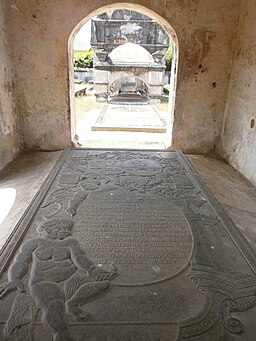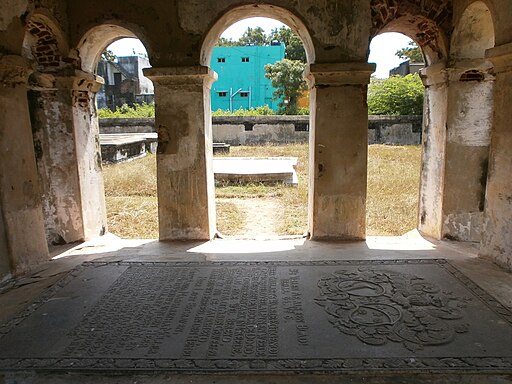To celebrate 5 years of blogging, I have decided to finally open my blog to guest bloggers. I present below the first guest post on my blog by Destination Infinity, a 31 year old blogger from Chennai (India) who claims to have an opinion on everything and is an expert on nothing! He has been blogging for more than six years @ destinationinfinity.org and has recently written an eBook - 'Happiness Guide for Tourists Visiting India: 50 Exciting Things To Do'.

Pulicat is a small coastal town that is located on the Tamil Nadu - Andhra Pradesh border, around 60 KM north of Chennai. Even people living Chennai might not be aware of this town or might only be familiar with the boating/bird-watching activities, there. But did you know that this almost forgotten town, was once the largest port throughout the Coromandel coast of India, in the 15/16th centuries? At that time, Chennai (Madras) was not even existent! Did you know that the Portuguese, Dutch and the English fought for controlling this port town, which has been in existence from 2nd Century BC? Did you know that this small town was the Dutch Coromandel headquarters for almost a century and they had built a huge fort here? Let's put this town back into the place it deserves, in history.

Pulicat or Pazhaverkadu (as the town is called in Tamil) has a large lake (18% in TN and the rest in AP). The main activity of people today involves catching fishes/crabs, that are sold in other parts of India or exported. But this town was once famous for its textiles. That's how the Dutch became familiar with it - They would exchange spices from South East Asia with cotton textiles manufactured in Pulicat. This town was bustling with activity when the Dutch started to establish themselves here in 1610. But, they were not the first Europeans to set foot on this coastal town, as the Portuguese had already set up their base after having struck an agreement with the Vijayanagara Kings.

The Dutch strengthened their base and after a few wars, they defeated Portuguese and took control of Pulicat. They initially established a factory at Pulicat, but soon they built a large fort (Geldria) and Pulicat became the Dutch headquarters in the Coromandel coast. Many people don't know that the Dutch presence in India lasted well over two centuries (from 1605 to 1825), and the Dutch VOC (Verenigde Oostindische Compagnie) was the largest European trading company in India, before the British East India company. The Dutch even had their own mint in Pulicat and they issued 'Pulicat' Dutch coins, which was used for trading.

The photos you see in this post were taken at the New Dutch Cemetery that was established in 1656 AD. There is an older cemetery where the Dutch, Portuguese and Indians were buried, but that area is largely inaccessible, today. This cemetery is an important piece of history that has survived and even today people from The Netherlands visit this place. It has 77 graves and all of them have stones with inscriptions about the dead, in the Dutch language. Five graves have domes/structures built over them. The entrance, as you can see in the first photograph, is a creatively built gate with skeletons on either side and a skull on the top. The inscriptions on the stones have been done artistically (with designs). The cemetery is now protected by the ASI, but even before that not much damage was done to it. People were afraid of the dead, maybe? :)

What you see in the below photo is an old house (now in ruins) inhabited by a Dutch family, earlier. There are many such houses built by the Dutch, that still survive in Pulicat but many are occupied now. The large container pots you see there were used to store water. Actually, people used to catch rain water in these vessels and insert an hot iron rod into them, in order to purify the water. That way, it seems, the water remains pure for a whole year and it is possible to drink from it!

We were taken on a heritage walk around Pulicat by AARDE Foundation (aarde.in) on the Pulicat Day (January 2013) and these photos were taken during that walk. I should thank the personnel from AARDE for having explained the history of Pulicat so well, and for having taken us around the few surviving monuments. This site is already protected by the ASI and they are trying to get the UNESCO World Heritage Site status to the monuments of Pulicat. Here's wishing them all the very best in their efforts.
Attribution: By Destination8infinity (Own work) [CC-BY-SA-3.0 (http://creativecommons.org/licenses/by-sa/3.0)], via Wikimedia Commons
19 comments:
Good to know. I had written about the French in Chandannagore near Kolkata. Colonial memories but still hidden gems.
Thanks for publishing my guest post TF. It was a pleasure writing for your blog :)
Destination Infinity
Congrats on completing 5 yrs--that is quite an achievement.
Nice start for guest post. Informative with really supportive photos...
Thanks D.I. for the lovely post and photographs. Little know facts about a place I have heard of.
Many, many happy returns of the day, Lucifer Inc!
Didn't know about this rich heritage existing since 2 BC, and a hotbed of mercantile and military activities. The ruins and residues of the dwelling units both in and after life paint a fine picture of its hay days. I am grateful to Destination Infinity for turning the floodlight on this languishing destination.
Interesting to know about small enclaves that still preserve remnants from history.
My Pleasure hosting you, Rajesh.
Thanks Indu.
Thanks paresh
Thanks Umashankar. It was enlightening to me as well.
TF, Congratulations on the fifth anniversary!
DI, Enjoyed that virtual walk through. Even though I was never a history fan, pictures and background information that's laid out well does make it interesting enough to read through the entire post!
Cheers,
Deepa
Ten Reasons why I didn't Post
Congrats on completing 5 years and very informative post there Destination Infinity !
Thanks Deepa.
Thanks Jaish.
5 years?! Hats off to your persistence...btw, the history of Pulicat is interesting :)
Thanks Pankti.
There are many towns that lie in oblivion. Nice to know you completing five years of blogging. Wishes..
Thanks Diwa. Yes. These smaller towns are interesting indeed.
Post a Comment
Kind words of appreciation/feedback